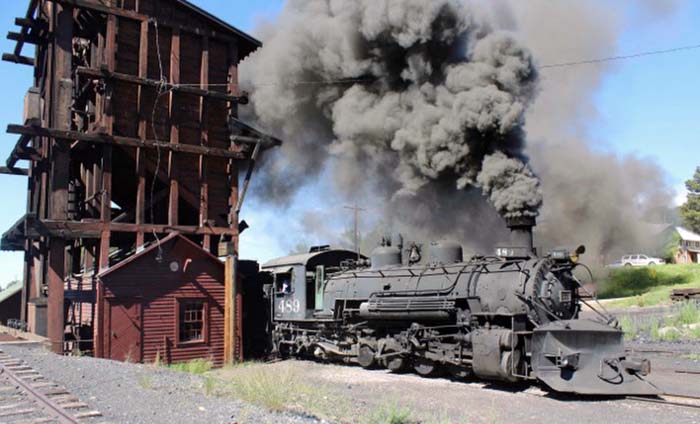
Chama New Mexico USA - In the thick of swirling plumes of coal-fired smoke and greasy engine parts, 11 men, mostly middle-aged and clad in blue overalls and steel toed boots, are getting ready for a day of class.
Everyone's standing in the tiny rail village of Chama, New Mexico, gazing at clanging, heaving locomotives.
"It's a strange beast," says Tom Chenal, a sheep farmer who hails from New Jersey.
For him, it almost seems alive, "like it's got a heartbeat or something."
Each of the men here are signed up for a rare and remote school near the Colorado-New Mexico border, the Cumbres & Toltec engineer and fireman school.
Dating back to 1880 with a mission to tap the resources of the southern Rockies, the Cumbres & Toltec Scenic Railroad is the highest and longest steam operated railroad in the country.
A National Historic Landmark, tourist trains lumber daily between Chama and Antonito during the summer and fall seasons.
"This whole operation here is very much a time capsule," says Ed Beaudette, the railroad's manager of engineering and operations.
"It's one of those few places where you can get out of your modern Mercedes or Cadillac and step onto the gravel pavement, and look around, and then you are back in 1925."
It's day two of the 4 day class and instructors prepare the men for their first day in Engine 487.
They'll be operating their own train, separate from the steam horse that conducts the sightseers.
Before they arrived the students read hundreds of pages of manuals as homework.
"If you get nervous, or if you don't know the next step, don't be scared to ask questions, we're here to help you guys," conductor Chris Aira tells the men.
The students rotate turns in the locomotive, in groups of three, as the train travels through alpine meadows, aspen groves, steep mountain canyons, and climbs past a sheer rock face to the 10,022 foot Cumbres Pass Summit.
Later, when they run the full 64 miles of the railroad, they'll inch along the 800 foot Toltec Gorge and follow the rushing Rio de los Pinos.
"In general it starts out with a mild amount of terror," Beaudette says of the students' demeanor.
Not to worry, alongside them in the locomotive are professional railroaders.
"As soon as they actually get something moving, the terror tends to go away and they really get wrapped up in it, they come off all smiles," he says.
"It's really quite an adrenalin-producing experience for them."
Even though they're trainees, it seems like a well-orchestrated team in the locomotive.
Engineer instructor Ronnie Lopez explains to Tom Chenal how to negotiate the tricky start on one of the steepest segments, telling him to ease back the brake and give it some throttle.
Andy Taylor, on fireman duty, shovels coal into the blazing hot firebox.
He keeps an eye on the pressure gauge, shooting for 195.
At 200, safety valves lift and you'll waste steam and water.
At the moment, the train is plodding uphill, so it's a lot of work.
Taylor says he began lifting weights and running extra miles nine months before he came here so he wouldn't, if you'll forgive the pun, "run out of steam, so to speak."
Skip Auten from Parker, Colorado, monitors water levels as he pumps water into the boiler.
"I found out I'm not that cut out to shovel coal but I am cut out to turn knobs," he laughs.
Operating what one of the men calls "a hulking beast" is both very physical and a delicate balancing act, the right mix of water, steam pressure, and heat.
Student Tom Chenal says it's the same with driving Engine 487.
"This is loaded with subtlety, the sensitively of the throttle, the sensitivity of the brakes. They're exquisitely sensitive," he says.
Trainees have to stick their heads out the window a fair bit to see the track and the grade coming.
John Grigsby, a saw mill operator from Arkansas, says you need to listen to the train.
"You don't have to have a speedometer because there isn't one, and as you ride, the railroad kind of tells you what to do, by feel."
When the men aren't in the locomotive, they ride in one of the cars and compare notes.
They marvel at the steam engine's durability and simplicity compared to their day jobs.
There's no crashing hard drives or out of date computers to worry about.
If you make a mistake, you can recover pretty quickly or fix it says Ed Lichtenfels of Littleton, Colorado.
Not so with the software he helped develop for a trip to Mars.
"You can do things like patch software, and correct for problems, but if you screw something up bad, you can't go to Mars and fix it," he says of the Mars MAVEN probe.
As you can imagine, many of these men had model trains as kids.
They like learning about new machinery and they're drawn to one that uses all of a human's senses, something that's been lost with modern day technology.
Retired aerospace engineer Chris Weiser is here learning what makes a locomotive move because he's making the switch from designing and building light weight aircraft to building a heavy steam locomotive in Ridgway, Colorado.
The depot there was once part of the Rio Grande Southern railway which ran from Durango to Ridgway.
Why the change for Weiser?
"Because it isn't there and we want to put it back," he says matter-of-factly.
For others, the engineering class is simply the chance to learn about something that's all but vanished.
Tom Chenal says that it's partly about tracing the roots of how we got to where we are today.
"I was curious how our predecessors did it and the more that I learned, the more I am in awe of what they accomplished."
Jenny Brundin.
provisions in Section 29 of the Canadian
Copyright Modernization Act.


